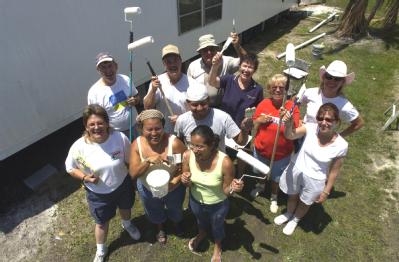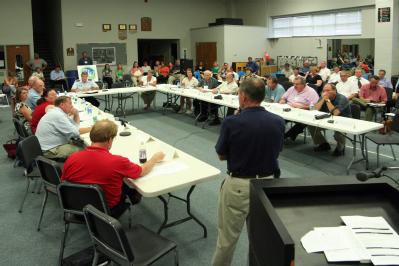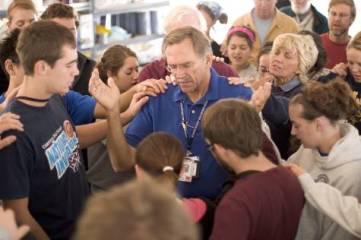Recovery: The Long Road Back to Eden
The sun comes up while you get the camp stove fired up on the back porch to make a pot of coffee. The first thing you hear is the sound of car tires on the street outside. Not a dump truck or a front loader or a utility truck – a car. When you look, it is a neighbor on his way to work at the regular time. For the past few weeks, everyone has been staying home or going to work at odd times, concentrating on clearing driveways and walkways, piling debris up near the curb for pickup, checking and patching shingles and the like. You notice the neighbor’s cat, outside for the first time since the storm, checking out a debris pile for hidden mice. Suddenly, your refrigerator starts up and a light comes on in the kitchen. The power is back on. Things are not back to normal but normal seems a possibility, now. (Ken Lott, HRP)
When communities begin the long process of getting back to normal after a disaster, the focus shifts from protecting life and property and creating safe, sanitary, and secure conditions to addressing the growing unmet needs that may surface over the long term.

In recovery, the source of assistance shifts from individual agencies with their own programs to efforts by community-based organizations through cooperative, collaborative and coordinated programs (FEMA photo)
- Damage assessments are conducted for press reports, insurance claims, and requesting a Presidential disaster declaration
- Vital services and facilities are gradually restored first to minimum operational standards and then to pre-disaster or better conditions
- Federal Emergency Management Agency (FEMA) coordinates U.S. government resources, providing grants, loans, and technical assistance in a disaster declared by the President. FEMA usually receives disaster registrations through a national 800 number and usually provides information and other support services through Disaster Resource Centers (DRCs)
- American Red Cross and other agencies working in the immediate relief effort wind down their operations
Spiritual Care for Caregivers
During recovery, the disaster-affected community also often experiences a sense of letdown. The length of time that it takes government, the faith community, and others engaged in long-term recovery activities to organize to begin rebuilding is part of the reason. However, the acute stress of responding to the immediate needs of survivors which infuses caregivers with energy and focus can leave them drained when the urgency of the situation passes. In the aftermath, they can experience varied emotional reactions, confused thoughts, physical difficulties (i.e., normal sleep patterns may be disrupted), and spiritual distress.
Although long-term recovery planners understand the need of survivors to continue to share their stories and make sense of what has happened even as the repairs to their house moves forward and the reminders of the disaster begin to fade, they all too often overlook caregivers in offering spiritual and emotional care once the disaster relief period has passed. Disasters may, in fact, impact health professionals, social service workers, and fire and police personnel more than the persons they serve. Indeed, hearing the stories of survivors and responding to the needs of others in acute stressful situations can leave them with secondary traumatic stress or compassion fatigue.
Information & resources. Several denominations now provide Care for Caregiver, Trauma Recovery and Resiliency, and Compassion Fatigue trainings to affected communities. A few denominations have special support services for clergy and church staffs. Contact your own denominational leadership for further information.
Community-Based Response
Perhaps most significantly in recovery, the source of assistance shifts from individual agencies with their own programs – both from inside and outside the disaster-affected community — to efforts by community organizations through cooperative, collaborative, and coordinated programs. Congregations bring their activities around spiritual care, direct assistance to survivors, volunteer coordination, and donations management to the common table.

Religious and secular organizations in cooperation provide the greatest benefit to a disaster-affected community by avoiding duplication of services (FEMA photo)
This shift to community-based groups occurs because a wide range of local people and organizations must own the disaster that has struck them and participate in the recovery process to address needs as fully as possible. For recovery to be most successful for the most people, representatives from all sectors of community life need to provide input and share in ownership of decisions and activities. At the same time, the shrinking limited resources available to meet continuing needs require them to work cooperatively and collaboratively and coordinate their activities. No one agency has the resources to respond alone. Information-sharing is vital. Dollars must be stretched and used efficiently.
Because elements necessary for healing are often already present in disaster-affected areas, community-based recovery groups seek to maximize the effectiveness of existing resources – local churches, community services, and volunteer programs. They do not deploy human energy and time or precious financial resources to build duplicate structures, but rather coordinate connection of available resources and service providers with those in need.
Long-Term Recovery Models
Historically, the religious community – compelled by faith and a commitment to equitable distribution of recovery resources – assumed responsibility for addressing long-term recovery needs through cooperation among its members. In today’s world, however, it is safe to assume that at least one of several cooperative structures – secular and religious — is in place as a foundation for developing community-based long-term recovery groups: a human services resource coordinating table, a local/ regional Voluntary Organizations Active in Disaster (VOAD), a ministerial association, Citizen Corps, United Way, the remaining skeleton of a past long-term disaster recovery group, Community Emergency Response Teams (CERTs), a faith-based disaster response network, a state or local emergency management agency, American Red Cross.
While participation of the religious community is vital to community recovery, assistance reaches families most efficiently and effectively when there is cooperation, collaboration, and coordination of the work among not only members of the religious community, but secular organizations and agencies as well. Local governmental and community human services agencies, now more than ever, are aware of the long-term recovery mission and are committed to bringing their own resources to the recovery. Together, religious and secular organizations in cooperation provide the greatest benefit to a disaster-affected community.
There are two common models for long-term recovery groups:
- Long-term Recovery Committee: The committee model brings together representatives from various disaster response and/or recovery agencies that individually address survivor needs through the case work process. Agencies with cases requiring resources beyond their capacities present them at committee meetings in which other agencies consider what they can contribute to help address the unmet needs. The committee normally does not have its own resources, 501(c)3 status, an administrative board, or even a dedicated staff. The committee may or may not address community needs in addition to individual or family needs. This model is sometimes called an Unmet Needs Committee.
- Long-term Recovery Organization: Like the committee model, the organization model encompasses multiple participants. However, it works as a single entity that may administer a pool of resources brought to the long-term recovery effort by its individual members. Separate funds as well may be administered by the organization members or partners. The organization has formal, identified leadership (board) and staff (volunteer, paid, or seconded), operates under its own 501(c)3 or an umbrella organization’s, and includes representatives of local faith groups, human services agencies, and disaster recovery organizations — all of which can provide resources. Often the organization has taskforces that address community-wide recovery needs as well as needs of families.
These two models may be adapted as a combination or refined in line with a community’s resource assets and recovery needs. Some common adaptations or refinements:
- Interfaith or Faith-based Long-term Recovery Organization/Committee: In many situations, the faith community plays a significant role in the formation of the long term recovery group. Either the committee or organization model may be partially or wholly faith-based. Historically, the long-term recovery committee or organization was called an interfaith but this is much less the case now.

Working collaboratively, agencies expand their opportunity to assist survivors and stretch their resources to assist survivors most effectively and efficiently. (FEMA photo)
- VOAD or COAD (Voluntary/ Community Organizations Active in Disaster): At the national and state levels, VOADs are understood to be planning, training, networking, and coordinating bodies whose members provide services and resources as individual agencies. At the local level, however, the VOAD or COAD may be the point at which collaborative assistance to persons and families begins and may, in fact, function as the long-term recovery committee/ organization.
Creating a new committee or organization may not even be necessary if recovery leadership can identify an existing organization that is willing to accept the coordinating role and is open to inclusion of new partners. Operating as a sub-group of an existing agency can provide instant tax-exempt status, built-in systems for receiving contributions and accounting, and association with an organization that has a history in the community.
The recovery effort will garner the greatest support and most resources when a collaborative partnership is created which includes the most responders. For individual care-giving agencies, a collaborative approach:
- Expands each agency’s opportunity to assist survivors they might not have otherwise encountered & streamlines case work process
- Makes possible the best & most extensive use of each agency’s resources and services (especially important when resources are limited)
- Allows agencies to share information about cases they are serving & avoid duplication of benefits
- Opens access for each agency’s cases to the full range of resources available in the community
- Gives the agencies benefit of committee thinking/action on cases vs. single agency action, decision-making, and recovery plans resourcing (especially helpful for the client when the need is great and/or complex)
- Helps provide equitable and consistent levels of assistance to individuals and families
For disaster survivors, benefits include:
- Simultaneous access to all recovery agencies with assistance programs (they don’t have to go from agency to agency)
- Collective creative problem solving skills of many experienced case workers
- A broad approach to their cases beyond the history or bias of a particular agency or case worker
- A system of follow-up, referrals & consistent case work process across the scope of the disaster
- Attention and assistance that is consistent with what is received by others in their community
Organizing to Work Together
After a major disaster in your community, state and/or local VOADs and/or FEMA Voluntary Agency Liaisons (VALs) will call meetings of all care-giving organizations where they can share information and learn and about how the community was affected and the ongoing response. At these meetings, officials will also begin to look towards long-term recovery.

FEMA and state/local VOADs call meetings of care-giving organizations to share information and begin to think about long-term recovery. (FEMA photo)
Attend these meetings and encourage others from the religious community to participate as well. You will gather important information that will affect decision-making about religious community participation in the long-term recovery process:
- Geographic area affected
- Housing impact: primary homes or vacation homes
- Percentage of persons with adequate or partial insurance coverage
- The most vulnerable people (marginalized before the disaster) and where they are located
- Status of disaster: continuing or ended
- Nature of hazards
- Human-caused technological/environmental components of the disaster

Members of the religious community must determine if they want to participate in a common cooperative response and explore the resources they can contribute. (Presbyterian Disaster Assistance photo)
Contact regional church executives and ministerial association, or councils of churches, not only to encourage them to participate in the meetings called by others, but – even more importantly – to initiate emergency meetings of religious leaders or an already established interfaith group in which they can claim their unique shared concern, history, and roles in the suffering and helping community. Also reach out personally to colleagues in ministry in your neighborhood who often will respond more readily than representatives of a formal group. In planning religious community participation in the long-term recovery process, faith leaders need to:
- Recognize the importance of working together in a shared ministry to those affected by disaster
- Determine if they want to participate in a common and cooperative response based on immediate relief and long-term recovery needs
- Explore the available resources (local, regional, state or territory) – volunteers, funds, material donations, spiritual care, case management services — the religious community can bring to a long-term recovery program
- Consider the religious community’s role in regard to organizations outside the religious community
- Explore need for outside funding or technical assistance in doing carrying out their long-term recovery activities in the community
Among key questions facing religious leaders:
- Will a cooperative community-based recovery program be necessary based on the amount of unmet needs likely — particularly among vulnerable people?
- How will they participate in the effort? As separate congregations and agencies participating in a wider community-based program or through an interfaith organization which they join – or both? Will they need to form a new organization?
If religious leaders decide to work together as an interfaith group and/or within the context of wider community-based program, they will be part of an organizing process that encompasses:
- Writing and publicizing a short mission or purpose statement for the shared disaster response
- Fundraising immediately and saving resources for long-term recovery
- Projecting needed program
- Establishing criteria for assistance
- Projecting needed staffing
- Developing a flexible budget that can be revised up or down as more information comes available
- Planning a volunteer management program which includes recruitment, training, placement, supervision, nurturing, and evaluation
- Partnering with the American Red Cross, Federal Emergency Management Agency (in a federally-declared disaster), and other immediate responders to assure a fully coordinated response
Information & Resources: As the transition from agency-based to community based recovery unfolds, Church World Service (CWS) Emergency Response Specialists (ERSs) can offer local groups important guidance through training and mentoring. Denominational disaster recovery organizing consultants trained by CWS are also available to counsel religious leaders and accompany them through the recovery organizing process.
ERSs coordinate on-site Tools & Training Workshops in which they and specialists from Christian Reformed World Relief Committee, Lutheran Disaster Response, Presbyterian Disaster Assistance, and United Methodist Committee on Relief cover the basics of recovery program organization, donations management, volunteer coordination, and case work. They also provide regular and customized online webinar trainings via the internet. On request, they draw on the CWS Community Arise curriculum to conduct trainings on site or via teleconference in specific areas of long-term recovery management.
The CWS manual — Managing and Operating a Disaster Long-Term Recovery Organization – and a web site version of it with complementary resources (www.disasterrecoveryhelp.org) – are handy references for directors and management staff of recovery groups. CWS may also help locate available resources and send blankets and emergency supply kits to congregations or faith-based recovery groups.
Have you got all this so far? It is a lot to absorb, to be sure, but that is why this training program and the resources listed in it are available to you as you move on to writing your own congregational plan.
